Respite Care Scotland, 2011-12
Presents information on respite care services provided or purchased by Local Authorities in Scotland. Respite Care is a service intended to benefit a carer and the person he or she cares for by providing a short break from caring tasks.
This document is part of a collection
3. Total number of respite weeks provided in Scotland
This statistical release presents the number of respite weeks provided to all age groups within Scotland.
Over the last few years, Local Authorities have been improving and refining their data collection methodologies (see section 4.2.2 for further details). This means that two different figures are presented for each year: 1) a comparable figure based on the same methodology as the previous year; and 2) a figure based on the revised methodology, which is not comparable to previous years but comparable going forward. Using this approach allows Local Authorities to revise their methodologies whilst still allowing for actual changes in respite provision to be identified.
The diagrams below shows how the figures will be presented in this release within tables and charts. There are four sets of comparable figures, 2007/081 & 2008/091, 2008/092 & 2009/102, 2009/103 & 2010/113 and 2010/114 & 2011/124.
Diagram 1: Example presentation of respite figures (Table)

1 - Same methodology used in 2007/08 & 2008/09 making the figures comparable
2 - Same methodology used in 2008/09 & 2009/10 making the figures comparable
3 - Same methodology used in 2009/10 & 2010/11 making the figures comparable
4 - Same methodology used in 2010/11 & 2011/12 making the figures comparable
Diagram 2: Example presentation of respite figures (Chart)
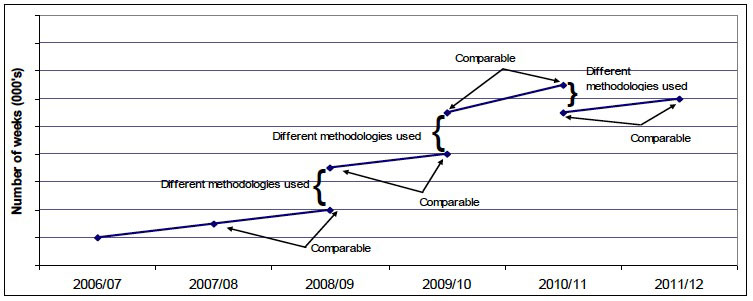
Refer to the background notes for more details on methodology changes and to the annexes for detailed information on respite weeks provided in each Local Authority in Scotland.
3.1 Respite weeks provided to all ages
Table 1 presents four different sets of comparable data which each show an increase in respite provision. The increase in the total number of respite weeks for each year is:
- increase of 0.8% (1,300 weeks) from 172,730 in 2007-081 to 174,030 in 2008/091
- Increase of 4.0% (7,860 weeks) from 195,710 in 2008/092 to 203,570 in 2009/102
- increase of 0.7% (1,410 weeks) from 209,800 in 2009/103 to 211,210 in 2010/113
- increase of 0.8% (1,670 weeks) from 203,730 in 2010/114 to 205,400 in 2011/124.
Looking at respite provision over all four of the different sets of comparable figures in Table 1, shows an increased from 172,730 weeks in 2007/08 to 205,400 weeks in 2011/12. This is a total increase of 32,670 weeks over the time period, of which 20,430 weeks is due to improved data recording and/or methodology changes and the remaining 12,240 weeks is due to an actual increase in respite provision.
Table 1: Number of respite weeks provided in Scotland, 2006/07 to 2011/12
| Number of respite weeks provided5 | |||||||||
|---|---|---|---|---|---|---|---|---|---|
| Respite weeks | 2006/07 | 2007/081 | 2008/091 | 2008/092 | 2009/102 | 2009/103 | 2010/113 | 2010/114 | 2011/124 |
| Overnight | 63,590 | 62,750 | 62,800 | 62,730 | 64,110 | 64,290 | 64,650 | 64,900 | 66,900 |
| Daytime | 100,050 | 109,980 | 111,230 | 132,980 | 139,460 | 145,510 | 146,570 | 138,820 | 138,500 |
| Total | 163,640 | 172,730 | 174,030 | 195,710 | 203,570 | 209,800 | 211,210 | 203,730 | 205,400 |
| % of respite (Daytime) | 61% | 64% | 64% | 68% | 69% | 69% | 69% | 68% | 67% |
Source: Audit Scotland SPI data 2006/07-2008/09, Scottish Government 2009/10, 2010/11 & 2011/12
1 - Same methodology used in 2007/08 & 2008/09 making the figures comparable
2 - Same methodology used in 2008/09 & 2009/10 making the figures comparable
3 - Same methodology used in 2009/10 & 2010/11 making the figures comparable
4 - Same methodology used in 2010/11 & 2011/12 making the figures comparable
5 - All figures rounded to the nearest ten.
Figure 2: Overnight and Daytime Respite weeks provided in Scotland, 2006/07 to 2011/12
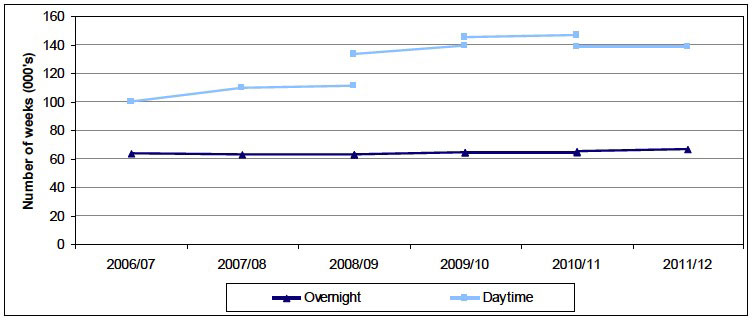
Source: Audit Scotland SPI data 2006/07-2008/09, Scottish Government 2009/10, 2010/11 & 2011/12
Looking more closely at Table 1 and the type of respite provided it is clear that the majority of respite provided is daytime. In 2006/07 daytime respite accounted for 61% of all respite provided, this increased to 67% in 2011/12. This percentage has been affected by methodology changes as local authorities find it much harder to identify daytime respite. For further details please refer to the background notes.
3.2 Respite weeks provided to older adults (Aged 65+)
Table 2 presents four different sets of comparable data which each show an increase in respite provision. The increase in the total number of respite weeks provided to older adults aged 65 and over in Scotland for each year is:
- increase of 3.4% (3,010 weeks) from 89,730 in 2007/081 to 92,740 in 2008/091
- increase of 1.8% (1,830 weeks) from 103,870 in 2008/092 to 105,700 in 2009/102
- increase of 0.9% (1,020 weeks) from 108,510 in 2009/103 to 109,530 in 2010/113
- increase of 2.6% (2,140 weeks) from 103,250 in 2010/114 to 105,390 in 2011/124.
Looking at respite provision over all four of the different sets of comparable figures in Table 2, shows an increased from 89,730 weeks in 2007/08 to 105,390 weeks in 2011/12. This is a total increase of 15,660 weeks over the time period, of which 7,660 weeks is due to improved data recording and/or methodology changes and the remaining 8,000 weeks is due to an actual increase in respite provision.
Table 2: Number of respite weeks provided to older adults (Aged 65+) in Scotland, 2006/07 to 2011/12
| Number of respite weeks provided5 | |||||||||
|---|---|---|---|---|---|---|---|---|---|
| Respite weeks | 2006/07 | 2007/081 | 2008/091 | 2008/092 | 2009/102 | 2009/103 | 2010/113 | 2010/114 | 2011/124 |
| Overnight | 37,250 | 36,870 | 36,040 | 35,990 | 35,740 | 35,790 | 37,620 | 37,610 | 39,120 |
| Daytime | 48,020 | 52,860 | 56,700 | 67,880 | 69,960 | 72,720 | 71,910 | 65,640 | 66,270 |
| Total | 85,270 | 89,730 | 92,740 | 103,870 | 105,700 | 108,510 | 109,530 | 103,250 | 105,390 |
| % of respite (Daytime) | 56% | 59% | 61% | 65% | 66% | 67% | 66% | 64% | 63% |
Source: Audit Scotland SPI data 2006/07-2008/09, Scottish Government 2009/10, 2010/11 & 2011/12
1 - Same methodology used in 2007/08 & 2008/09 making the figures comparable
2 - Same methodology used in 2008/09 & 2009/10 making the figures comparable
3 - Same methodology used in 2009/10 & 2010/11 making the figures comparable
4 - Same methodology used in 2010/11 & 2011/12 making the figures comparable
5 - All figures rounded to the nearest ten.
Figure 3: Overnight and Daytime Respite weeks provided to older adults (Aged 65+) in Scotland, 2006/07 to 2011/12
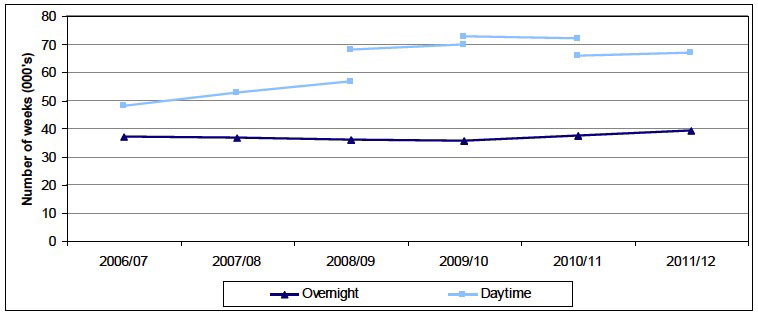
Source: Audit Scotland SPI data 2006/07-2008/09, Scottish Government 2009/10, 2010/11 & 2011/12
Table 2 shows that the majority of respite provided to older adults is daytime respite. In 2006/07 daytime respite accounted for 56% of all respite provided, this increased to 63% in 2011/12. This percentage has been affected by methodology changes as local authorities find it much harder to identify daytime respite. For further details please refer to the background notes.
3.3 Respite weeks provided to adults (Aged 18 to 64)
Table 3 presents four different sets of comparable data which each show the change in respite provision. The change in the total number total number of respite weeks provided to adults aged from 18 to 64 in Scotland in each year is:
- a decrease of 1.0% (590 weeks) from 59,050 in 2007/081 to 58,460 in 2008/091
- an increase of 6.8% (4,720 weeks) from 69,070 in 2008/092 to 73,090 in 2009/102
- an increase of 0.9% (690 weeks) from 76,950 in 2009/103 to 77,640 in 2010/113
- a decrease of 0.7% (560 weeks) from 77,640 in 2010/114 to 77,040 in 2011/124.
Looking at respite provision over all four of the different sets of comparable figures in Table 3, shows an increase from 59,050 weeks in 2007/08 to 77,040 weeks in 2011/12. This is a total increase of 17,990 weeks over the time period, of which 13,770 weeks is due to improved data recording and/or methodology changes and the remaining 4,220 weeks is due to an actual increase in respite provision.
Table 3: Number of respite weeks provided to adults (Aged 18 to 64) in Scotland, 2006/07 to 2011/12
| Number of respite weeks provided5 | |||||||||
|---|---|---|---|---|---|---|---|---|---|
| Respite weeks | 2006/07 | 2007/081 | 2008/091 | 2008/092 | 2009/102 | 2009/103 | 2010/113 | 2010/114 | 2011/124 |
| Overnight | 17,650 | 18,030 | 18,760 | 18,690 | 20,180 | 20,300 | 19,550 | 19,850 | 20,120 |
| Daytime | 38,120 | 41,020 | 39,700 | 50,380 | 53,620 | 56,650 | 58,090 | 57,790 | 56,920 |
| Total | 55,770 | 59,050 | 58,460 | 69,070 | 73,790 | 76,950 | 77,640 | 77,640 | 77,040 |
| % of respite (Daytime) | 68% | 69% | 68% | 73% | 73% | 74% | 75% | 74% | 74% |
Source: Audit Scotland SPI data 2006/07-2008/09, Scottish Government 2009/10, 2010/11 & 2011/12
1 - Same methodology used in 2007/08 & 2008/09 making the figures comparable
2 - Same methodology used in 2008/09 & 2009/10 making the figures comparable
3 - Same methodology used in 2009/10 & 2010/11 making the figures comparable
4 - Same methodology used in 2010/11 & 2011/12 making the figures comparable
5 - All figures rounded to the nearest ten.
Figure 4: Overnight and Daytime Respite weeks provided to adults (Aged 18 to 64) in Scotland, 2006/07 to 2011/12
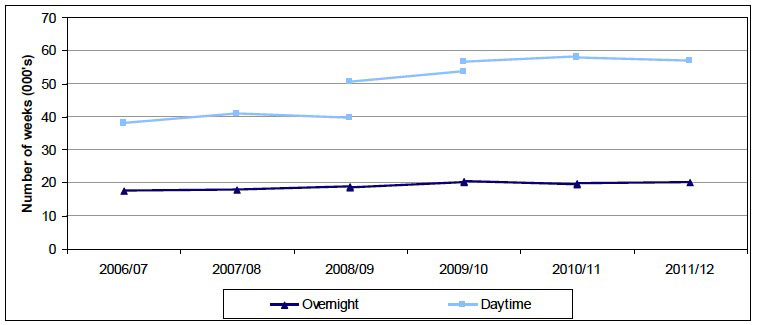
Source: Audit Scotland SPI data 2006/07-2008/09, Scottish Government 2009/10, 2010/11 & 2011/12
Table 3 shows that in 2006/07 daytime respite accounted for 68% of all respite provided, rising to 74% in 2011/12, which is the highest percentage for any age group. This percentage has been affected by methodology changes as local authorities find it much harder to identify daytime respite. For further details please refer to the background notes.
3.4 Respite weeks provided to young people (Aged 0 to 17)
Table 4 presents four different sets of comparable data which each show the change in respite provision. The change in the total number of respite weeks provided to young people aged from 0 to 17 in Scotland in each year is:
- a decrease of 4.7% (1,120 weeks) from 23,950 in 2007/081 to 22,830 in 2008/091
- an increase of 5.8% (1,310 weeks) from 22,770 in 2008/092 to 24,080 in 2009/102
- a decrease of 1.2% (300 weeks) from 24,340 in 2009/103 to 24,040 in 2010/113
- an increase of 0.6% (140 weeks) from 22,830 in 2010/114 to 22,970 in 2011/124.
Looking at respite provision over all four of the different sets of comparable figures in Table 3, shows an increased from 23,950 weeks in 2007/08 to 22,970 weeks in 2011/12. This is a decrease of 980 weeks over the time period, which is due to improved data recording and/or methodology changes as there has been a 30 week increase in actual respite provision over the time period.
Table 4: Number of respite weeks provided to young people (Aged 0 to 17) in Scotland, 2006/07 to 2011/12
| Number of respite weeks provided5 | |||||||||
|---|---|---|---|---|---|---|---|---|---|
| Respite weeks | 2006/07 | 2007/081 | 2008/091 | 2008/092 | 2009/102 | 2009/103 | 2010/113 | 2010/114 | 2011/124 |
| Overnight | 8,690 | 7,850 | 8,000 | 8,050 | 8,200 | 8,200 | 7,470 | 7,450 | 7,670 |
| Daytime | 13,920 | 16,100 | 14,830 | 14,720 | 15,880 | 16,140 | 16,570 | 15,390 | 15,300 |
| Total | 22,610 | 23,950 | 22,830 | 22,770 | 24,080 | 24,340 | 24,040 | 22,830 | 22,970 |
| % of respite (Daytime) | 62% | 67% | 65% | 65% | 66% | 66% | 69% | 67% | 67% |
Source: Audit Scotland SPI data 2006/07-2008/09, Scottish Government 2009/10, 2010/11 & 2011/12
1 - Same methodology used in 2007/08 & 2008/09 making the figures comparable
2 - Same methodology used in 2008/09 & 2009/10 making the figures comparable
3 - Same methodology used in 2009/10 & 2010/11 making the figures comparable
4 - Same methodology used in 2010/11 & 2011/12 making the figures comparable
5 - All figures rounded to the nearest ten.
Figure 5: Overnight and Daytime Respite weeks provided to young people (Aged 0 to 17) in Scotland, 2006/07 to 2011/12
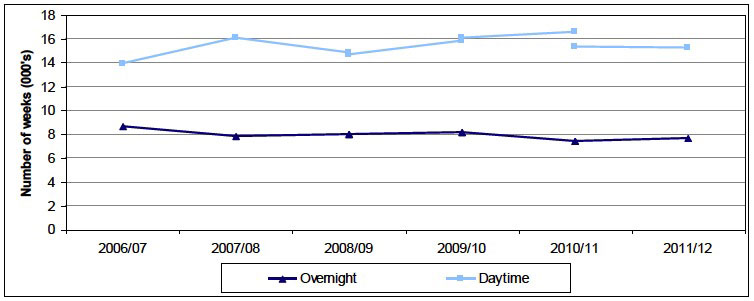
Source: Audit Scotland SPI data 2006/07-2008/09, Scottish Government 2009/10, 2010/11 & 2011/12
Looking more closely at Table 4 shows that the majority of respite provided is daytime. In 2006/07 daytime respite accounted for 62% of all respite provided, this is now 67% 2011/12. This percentage has been affected by methodology changes as local authorities find it much harder to identify daytime respite. For further details please refer to the background notes.
Contact
Email: Steven Gillespie
There is a problem
Thanks for your feedback